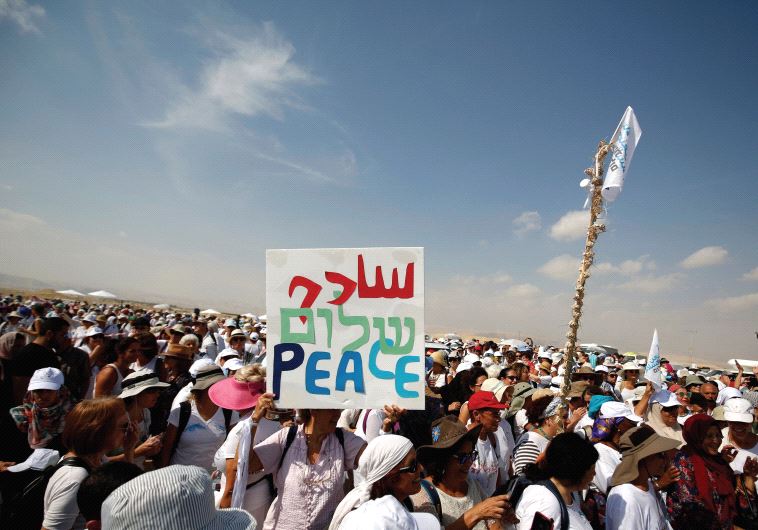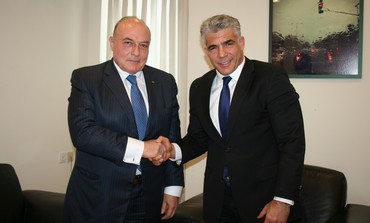If a miracle happened today and Prime Minister Benjamin Netanyahu would call Palestinian Authority President Mahmoud Abbas and say: Let’s renew negotiations based on former prime minister Ehud Olmert’s last proposal, Abbas would jump at the opportunity and resume talks. In 2012 and 2013, I met with Abbas privately for hours and he allowed me to propose to Netanyahu the renewal of direct secret back channel negotiations on the basis of the Olmert proposal. Netanyahu refused all three times I passed on these proposals.
The last offer was made at the beginning of the John Kerry nine-month initiative and at that time the Americans vetoed any other track for negotiations other than the one that they were running. They didn’t have to use the veto because Netanyahu was most definitely opposed to renewed negotiations on any terms other than his own. If in any event this miracle were to happen today, the main obstacle to the Olmert proposal from reaching agreement was not the issue of Jerusalem, refugees, or security; it was the delineation of the border.
Just as a reminder, the following are the main elements of the Olmert offer from September 2008:
• Israel would cede 94% of the West Bank for the establishment of a Palestinian state.
• Israel would annex 6.4% of the West Bank. Isolated settlements would be evacuated, but Gush Etzion, Ma’aleh Adumim and Ariel would be annexed by Israel with territorial swaps equaling 5.8% of West Bank.
• A safe passage between the West Bank and Gaza would be established.
• Jerusalem will be the capital of both states. Jewish neighborhoods in Jerusalem would be under Israeli sovereignty, Arab neighborhoods would be under Palestinian sovereignty.
• No one would have sovereignty in the holy basin in Jerusalem containing sites holy to Jews, Muslims and Christians. This area would be jointly administered by five nations: Saudi Arabia, Jordan, Palestine, Israel and the United States.
• No right of return for Palestinian refugees. Israel would agree on a humanitarian basis to accept 1,000 refugees every year for five years. An effort would also be made to establish an international fund to compensate Palestinians for their suffering. The agreement would also include recognition of the suffering of Jews from Arab countries who were forced out of their homes after 1948. (Abbas wanted the number to be 150,000 over five years. In private, Olmert has said that he would have agreed to 30,000. They probably would have compromised on 50,000 to 60,000).
• Palestine would have a strong police force. It would have no army or air force.
• The Palestinian border with Jordan would be patrolled by international forces, possibly from NATO.
• Israel would retain the right to defend itself beyond the borders of a Palestinian state and to pursue terrorists across the border.
• Israel would be allowed access to airspace over Palestine.
If Netanyahu and Abbas were to resume the negotiations on this basis, it is very possible that agreement could be reached and a majority of Israelis and Palestinians would accept the deal. This would be, perhaps, the only way to save the two-state solution and peace might even develop if the sides actually implemented to what they agreed.
But this miracle will not occur and neither Netanyahu – nor Alternate Prime Minister Benny Gantz– would agree to the parameters of this deal. No Palestinian leader would accept less than this and therefore, no negotiations will take place in the foreseeable future. Abbas has lost most of his legitimacy on the Palestinian street and the West Bank and Gaza remain divided and in conflict. The overwhelming majority of the Palestinian diaspora would also reject this deal having moved far away from the two-state solution, as have a majority of Palestinian youth in the West Bank.
WHILE NO negotiations have taken place for 11 years, the situation on the ground has not remained frozen. The physical space for a Palestinian state has dwindled with increased Israeli settlement expansion and the availability of land on the Israeli side of the green-line for swaps has also diminished. The public on both sides have moved further away from believing that agreement is possible and the issue of Palestine is almost totally absent from the Israeli public discourse. The Netanyahu-authored Trump plan, which now seems that even Trump isn’t quite sure about, moved us further away from negotiations and the Palestinians have not only ended contact with the Americans, they have broken off all official contacts with Israel.
With or without annexation, Israel remains in control of the West Bank. Israeli control means continued Israeli violence against the Palestinian population. The Palestinian Authority carries out many of the duties which used to be relegated to the Israeli military government, but the dangers of future outbursts of animosity, uprisings and violence from Palestine toward Israel increase with each passing day. The West Bank is on the verge of financial collapse. The Palestinian Authority cannot carry the weight of the economic realities of occupation and the novel corona-virus. The Palestinians now direct their private frustrations towards the PA in the West Bank and towards Hamas in Gaza, but because of the iron fist of both of those regimes, protests are very limited. Outbursts against Israel will not be so limited by the Palestinian regimes and by the people in the street.
Israelis and Palestinians don’t really want another round of warfare. Palestinians don’t want to die in vain and they don’t want to lose their properties and what little livelihood they may have. But the inevitability of more violence can only be avoided if there were leaders with the wisdom and the fortitude to realize that agreements involving multi-faceted political / ethnic / religious / national conflicts must be based on mutuality, reciprocity and principles of justice.
Most Israelis and Palestinian recognize that the two-state solution belongs to the past, but it is hard to let go of an idea that has been so central to our political discourse for 25 years. It is virtually impossible to move from the two-state solution to the one-state solution. The idea of one-state, democratic with equal rights for all, including immigration and no national identity may seem utopian to some but it is not what most Israelis and most Palestinian really want.
The nearest vision that I know of preserving the concept of two-states, yet also recognizing the importance of all of the Land of Israel to Jews and all of the Land of Palestine to Palestinians is the plan called “A Land for All / Two States One Homeland.” This is a plan which also recognizes that no one should be forced to leave their home for peace to exist. It is a rational translation of a plan to confront many of the failings of the Oslo peace process. There are many holes in the plan, but the joint work done by Israelis and Palestinians to develop it is commendable. Like any Israeli-Palestinian peace plan, it is not for immediate implementation nor is there the naïve believe that agreeing on its parameters would put an immediate end to the conflict and peace would break out all over this land. “A Land for All” is a vision, a proposal; it aims to create dialogue, debate and to enlist more supporters. I recommend having a look at it.


